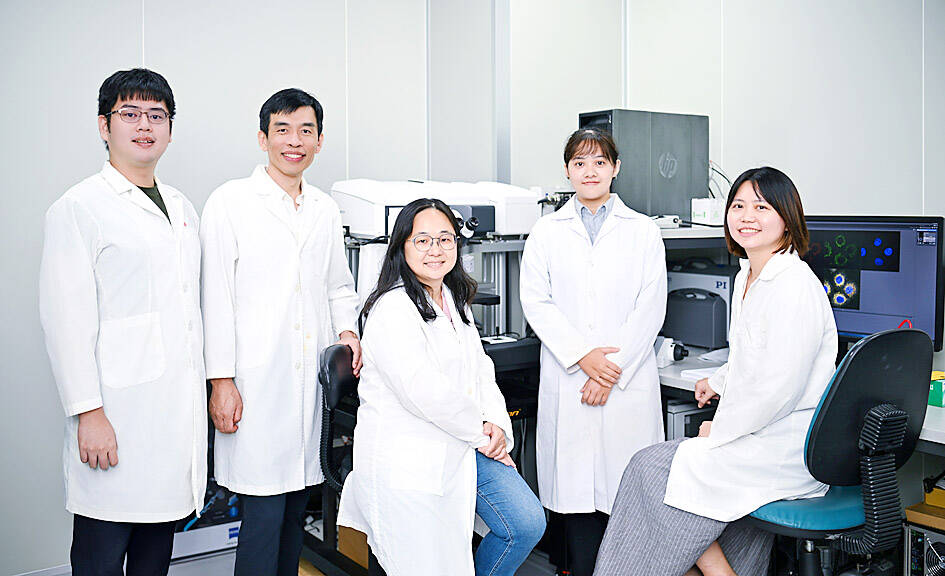Taiwanese scientists have identified a genetic mechanism behind the growth of brain tumors in children that could potentially be used to create more targeted cancer therapy, National Yang Ming Chiao Tung University said yesterday.
The university’s research team found that the TTBK2 and HUWE1 genes might play a key role in the spread of medulloblastoma, the most common type of brain cancer in children, it said in a statement.
The study, which utilized genetically manipulated mice and zebrafish, was published in the journal Cell Death & Differentiation in June last year.

Photo courtesy of National Yang Ming Chiao Tung University
The main clinical treatments for medulloblastoma are surgery, radiation therapy and chemotherapy, all of which are associated with risk of cognitive impediment, high cancer recurrence and other side effects, it said.
The research, which linked dysfunctions in specific genes to the propagation of medulloblastoma tumors, could contribute to the creation of new brain cancer treatments, said Tsai Jin-wu (蔡金吾), paper coauthor and professor of brain science at the university.
TTBK2 regulates the primary cilia of granule progenitor cells, which function as a kind of antenna that receives the signals guiding development of the undifferentiated cells into parts of the hindbrain, he said.
The related gene HUWE1 governs the growth of progenitor cells by disassembling the primary cilia after their purpose is complete, achieving a dynamic balance essential for normal development, Tsai said.
A malfunctioning HUWE1 breaks the dynamic balance by allowing the cells to proliferate unchecked, leading to the manifestation of brain tumors, he said.
By suppressing the TTBK2 expression, the team discovered that granule progenitor cells could be forced into shedding their antennae, resulting in a significant reduction in the rate of tumor growth, Tsai said.
Coauthor Wang Won-jing (王琬菁) said the study contradicted the scientific community’s previous belief that primary cilia were vestigial remains of evolution that serve no function.
Instead, the researchers uncovered that the cilia performed a vital function for granule progenitor cells by receiving the signals that would control their differentiation and division, she said.
The discovery means that primary cilia might be correlated to drug resistance of brain cancer cells, pointing to a possible method to develop targeted therapeutics for brain tumors, she added.

LIMITS: While China increases military pressure on Taiwan and expands its use of cognitive warfare, it is unwilling to target tech supply chains, the report said US and Taiwan military officials have warned that the Chinese People’s Liberation Army (PLA) could implement a blockade within “a matter of hours” and need only “minimal conversion time” prior to an attack on Taiwan, a report released on Tuesday by the US Senate’s China Economic and Security Review Commission said. “While there is no indication that China is planning an imminent attack, the United States and its allies and partners can no longer assume that a Taiwan contingency is a distant possibility for which they would have ample time to prepare,” it said. The commission made the comments in its annual

DETERMINATION: Beijing’s actions toward Tokyo have drawn international attention, but would likely bolster regional coordination and defense networks, the report said Japanese Prime Minister Sanae Takaichi’s administration is likely to prioritize security reforms and deterrence in the face of recent “hybrid” threats from China, the National Security Bureau (NSB) said. The bureau made the assessment in a written report to the Legislative Yuan ahead of an oral report and questions-and-answers session at the legislature’s Foreign Affairs and National Defense Committee tomorrow. The key points of Japan’s security reforms would be to reinforce security cooperation with the US, including enhancing defense deployment in the first island chain, pushing forward the integrated command and operations of the Japan Self-Defense Forces and US Forces Japan, as

‘TROUBLEMAKER’: Most countries believe that it is China — rather than Taiwan — that is undermining regional peace and stability with its coercive tactics, the president said China should restrain itself and refrain from being a troublemaker that sabotages peace and stability in the Indo-Pacific region, President William Lai (賴清德) said yesterday. Lai made the remarks after China Coast Guard vessels sailed into disputed waters off the Senkaku Islands — known as the Diaoyutai Islands (釣魚台) in Taiwan — following a remark Japanese Prime Minister Sanae Takaichi made regarding Taiwan. Takaichi during a parliamentary session on Nov. 7 said that a “Taiwan contingency” involving a Chinese naval blockade could qualify as a “survival-threatening situation” for Japan, and trigger Tokyo’s deployment of its military for defense. Asked about the escalating tensions

The Ministry of Economic Affairs said it plans to revise the export control list for strategic high-tech products by adding 18 items under three categories — advanced 3D printing equipment, advanced semiconductor equipment and quantum computers — which would require local manufacturers to obtain licenses for their export. The ministry’s announcement yesterday came as the International Trade Administration issued a 60-day preview period for planned revisions to the Export Control List for Dual Use Items and Technology (軍商兩用貨品及技術出口管制清單) and the Common Military List (一般軍用貨品清單), which fall under regulations governing export destinations for strategic high-tech commodities and specific strategic high-tech commodities. The